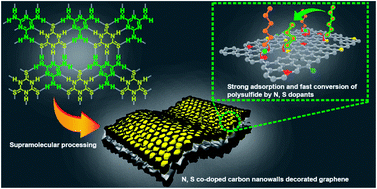Molecularly designed N, S co-doped carbon nanowalls decorated on graphene as a highly efficient sulfur reservoir for Li–S batteries: a supramolecular strategy†
Abstract
Sulfur is among the most promising cathodes for next-generation high energy storage systems. However, its practical applications have been hindered by its insulating nature (i.e., S and its discharge product Li2S), substantial volume changes, and detrimental shuttle effect (polysulfide intermediates). Nanostructured hosts with high conductivity and strong polysulfide entrapment are the prerequisites for high-capacity and long-cycle life Li–S batteries. Here, we report a carbonaceous host based on N, S co-doped carbon nanowall decorated graphene (NSCNW-G) via a supramolecular strategy, which simultaneously achieves abundant voids for sulfur species accommodation and fast redox kinetics of polysulfides. As a result, NSCNW-G/S delivers a high capacity of 1246 mA h g−1 at 0.02C, superb cycling stability with an ultralow decay rate of 0.021% per cycle for as long as 800 cycles at 0.5C, and a stable coulombic efficiency of up to 98% with a high mass loading of approximately 80 wt%. Even with a high areal loading of 3.2 mg cm−2, a capacity of 510 mA h g−1 is still retained after 300 cycles at 0.5C. Our present supramolecular strategy demonstrates a feasible pathway to the rational design of advanced carbonaceous materials for Li–S batteries and other electrochemical applications.



 Please wait while we load your content...
Please wait while we load your content...